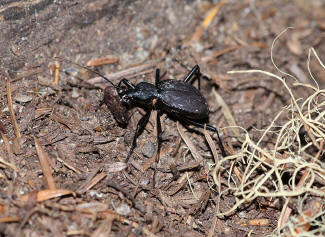Interactions
Land snails are extremely important to their environments in a variety of different ways: they are prey to a number of larger animals, although some snails are also predatory of other snails; they can be used to determine the quality of their habitat; they even serve as the camouflage for one very unique insect.
Research - Land snails play an integral part in the study of their respective environments. This is due to the small area of habitat within which they will spend their lives, which in turn is due to their small size and slow-moving nature. Therefore, the snail will take on specific chemical properties from its surrounding environment such as pollutants, which will be magnified within the snail due to their constant ingestion. Researchers can then examine the snails from a given area and use their midgut contents to determine the quality of the habitat in which they are found (Dourson, 2010). Snails are not only used to determine the extent of pollution in a habitat however. A study done in the Great Smoky Mountain National Park showed that a surplus deer population had drastically reduced the ground cover in the forest up to six feet and this has led to a heavy decline in local snail populations (Dourson et al, 2006). Another study done in the Mt. Airy Forest in Cincinnati has shown another heavy decline in snail populations, this time caused by a species of exotic earthworm that reduce the leaf and duff layers in which snails normally reside and feed (Dourson et al, 2006). Both of these studies have also seen a heavy decrease in the number of predatory species whose main prey is the land snail.
Predators - Euchemotrema fasciatum is an important food item for many predatory species including smalls mammals such as mice and shrew, salamanders, Scaphinotus and Cychrine beetles and other snails (Dourson, 2010). Due to its small size, Euchemotrema fasciatum will be eaten whole by mice, shrew and salamanders, but the Scaphinotus beetle has the unique adaptation of an extended mouth with which it will push its head into the shell of a snail and pull the snail out in order to be eaten (Dourson et al, 2006).
Calcium - The snail itself however is not the only important component in terms of consumption by predatory animals. In fact, a snail's shell is equally valuable as a calcium source, specifically for birds which require extra calcium in order to harden the shell of their eggs (Dourson et al, 2006). One study done in the Eastern United States actually shows a strong correlation between the declining number of wood thrushes and the reduction of snail populations due to acid rain (Hames et al, 2002). It is also interesting to note that other animals are not the only species in need of extra calcium from snail shells, but that snails will consume vacant shells in order to use the calcium to create their own. One very unique insect, known as the "junkyard bug," will also use the vacant shell of snails, not for the calcium, but will stick the shell onto its back along with leaf litter and various insect parts for use as camouflage.
Click here to proceed to our References.
This page created by Aaron Young.
[1].jpg)
